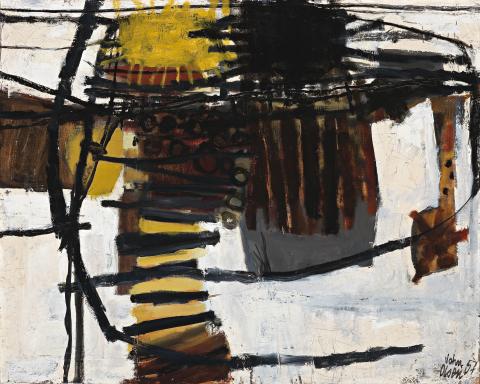LANDSCAPE NO 1, 1957
JOHN OLSEN
oil on canvas
74.0 x 90.0 cm
signed and dated lower right: John Olsen 57
Mrs Hanne Fairfax, Sydney
Thence by descent
Private collection, Sydney
John Olsen, Macquarie Galleries, Sydney, 6 – 18 August 1958, cat. 2 (as ‘Landscape’)
Antipodean Vision, Adelaide Festival of Arts, March 1962, cat. 161 (exhibition label attached verso)
Australian Painting: Colonial Impressionist Contemporary, [‘the Tate show’] The Tate Gallery London, January 1963 and touring to Vancouver and Ottawa, Canada, 1963
Bonython, K., Modern Australian Painting and Sculpture: A Survey of Australian Art 1950 to 1960, The Griffin Press Adelaide, 1960, p. 440 (illus.)
Luck, R.K., A Guide to Modern Australian Painting, Sun Books Ltd, Melbourne, 1969, p. 62 (illus.)
Spate, V., Australian Art Monographs: John Olsen, Georgian House, Melbourne, 1963, pp. 7, 10, 17, pl. 2 (illus.)
John Olsen’s Landscape No.1, 1957 is a powerfully urgent abstraction which bears witness to the artist’s own determined experimentation in the years preceding its creation. After studying with the Cézanne-obsessed John Passmore, Olsen was seeking something more, ‘an animist quality, a certain mystical throbbing throughout nature.’1 His friend, the sculptor Robert Klippel, ‘stressed the importance of becoming more involved with the act of painting’;2 whilst the older émigré artist Stanislaus Rapotec ‘(made) declarations that, like his paintings, carried a sense of black and thunder … an imperative urgency.’3 With the help of private patronage, Olsen left Australia in late 1956 travelling to London then France. E n route, he met many influential artists and was exposed to the work of numerous others. He also studied for a time at William Hayter’s renowned Atelier 17 print studio in Paris where its founder extolled ‘the surrealist movement … the splash and dribble of the action painters … and his love of Klee and Kandinsky.’ Olsen found further inspiration in the raw surfaces of paintings by Jean Dubuffet and Antoni Tàpies, and with this heady brew still percolating through his brain, he bought a Lambretta and rode down into Spain.
What he found was nothing short of a revelation, a country still locked in medieval tradition and ritual yet scarred by the wounds and graffiti of a modern civil war. Olsen was hooked and developed a great love for the Spanish people and their open-hearted generosity. Settling on the island of Majorca, he found a landscape drenched in sun offset by deep shadows. In many ways, black is one of the principal colours of Spain from its darkened religious monuments and statues celebrating its Moorish past, to the people themselves where ‘women still wore long black dresses; men wore … dark suits with striped shirts and flat black hats.’4 Drawing on his enriched artistic experiences, Olsen set about putting into practice all that he absorbed creating a suite of remarkable paintings which subsequently comprised his first solo exhibition in June 1958 at Sydney’s Macquarie Galleries. Not surprisingly, black was predominant, articulating symbols, cruciforms and circles set against pulsating painterly grounds. In the catalogue introduction, Olsen discussed the companion painting Dylan’s Country (now in the Collection of the Art Gallery of New South Wales): ‘I feel in paintings like Dylan’s Country that one gets a feeling of landscape as totality as opposed to the Renaissance ideal ‘here I stand, where I look is landscape’. This is too visual and its basic flaw is that it does not inhabit the landscape.’5 With its energised lines, ladders and circular meanderings, Landscape No.1 does indeed compel the eye to inhabit the space before concluding its restless journey with two sun motifs, one golden and one Spanish black. Wonderful and rare, Landscape No.1 is one of the most important early paintings by John Olsen to come on the market for many years.
1. Olsen, J., 1956 ‘Pacific Loan’ catalogue entry, cited in: Spate, V., Australian Art Monographs: John Olsen, Georgian House, Melbourne, 1963, p. 5
2. Smith, B., Australian Painting 1788–1970, Oxford University Press, Melbourne, 1971, p. 312 (author’s parenthesis)
3. Bungey, D., John Olsen: an artist’s life, HarperCollins, Sydney, 2014, p. 105
4. John Olsen, Drawn from Life, Duffy & Snellgrove, Sydney, 1997, p. 17
5. John Olsen, catalogue introduction, Macquarie Galleries, Sydney, 1958
ANDREW GAYNOR
